Located at the astonishing distance of about 21 million light-years from Earth, this beautiful grand-design spiral galaxy, conveniently called the Pinwheel, spans across 170 kly and is an example of magnificent deep-sky stellar factories.
Distance: 21 million light-years
Diameter: 170 000 light-years
Other designations: Messier 101 (M101), NGC 5457
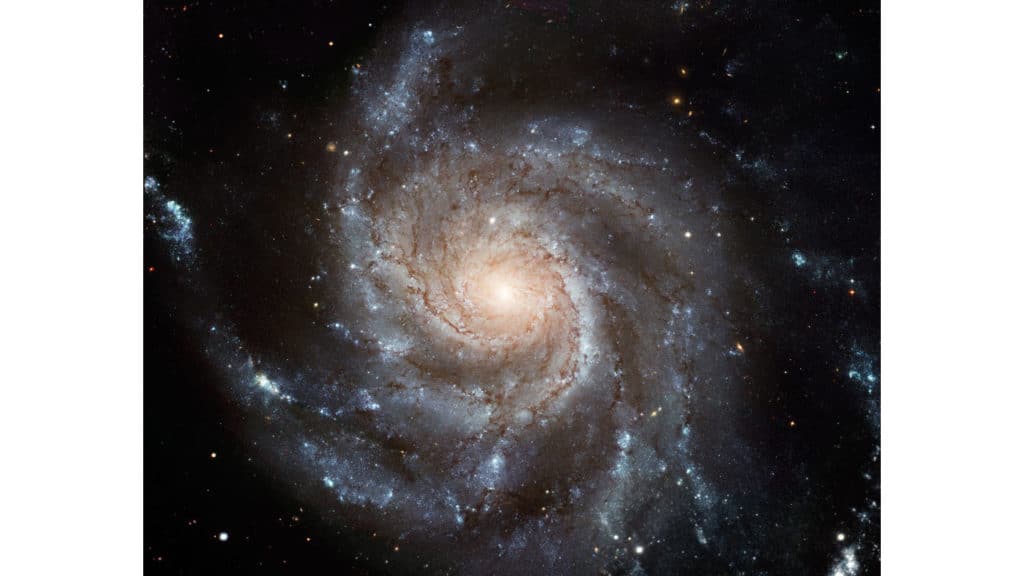
Constellation: Ursa Major (Great Bear)
Home to one of the closest supernovae that we observed in the modern history of astronomy, located at the distance of almost 22 million light-years, the Pinwheel galaxy with its head-on presentation in relation to the Earth reveals a stunning spiral structure par excellence.
History
The Pinwheel galaxy was first observed in the spring of 1781 by the French astronomer Pierre Méchain who reported his discovery to the famous colleague Charles Messier, the author of an astronomical catalogue listing 110 nebulae, faint star clusters and other deep-sky objects which later became known as the Messier objects. The Pinwheel galaxy was the 101th entry in the catalogue and was therefore dubbed Messier 101 or M101.
Though strikingly large in comparison to the Milky Way, the Pinwheel galaxy is very faint due to its long distance. The spiral structure of the galaxy was not observed until the late 19th century as the technology of the optical telescopes developed and improved further. The Anglo-Irish astronomer Lord Rosse was the first to look at the Pinwheel galaxy using a 72-inch Newtonian reflector and report its spiral structure.
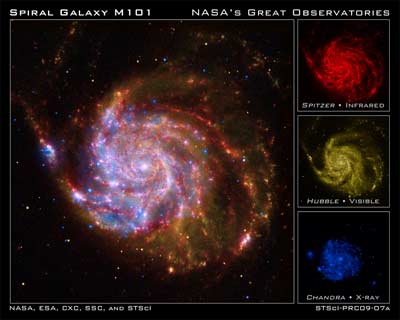
A 10-year long collaboration between the European Space Agency and NASA resulted in a stunning, most detailed image of the Pinwheel galaxy ever taken. The complex image was assembled from 51 individual exposures taken by the Hubble Space Telescope, as well as details from the images taken from the surface of the Earth. This breath-taking image released in 2006 depicts details of the two spiral arms swirling around the centre of the galaxy in a ground-breaking 16 000-by-12 000-pixel resolution.
Celebrating the International Year of Astronomy in 2009, NASA released a series of images that captured visible, infrared and X-ray wavelengths of the light coming from the M101. The images were taken by the Hubble Space Telescope, Spitzer Space Telescope, and Chandra X-ray Observatory and were put together into one multiwavelength picture. The images of the infrared light reveal dust and gas that can host star formation processes while the X-ray wavelengths reveal regions of matter excited to high-energy levels.
Characteristics
Though the Pinwheel galaxy is a near-perfect representation of a spiral galaxy, something rather strange in its centre distinguish it from most of other spirals in the known Universe. And we are not talking about a supermassive black hole, because there apparently isn’t one. Though the galaxy has been observed across a wide range of wavelengths, there were no findings of strong radio or X-ray emissions at the galaxy’s core. As opposed to the majority of spiral galaxies we have studied that typically rotate around one gigantic black hole, the Pinwheel seems to contain a bunch of smaller black holes no bigger than 3-30 solar masses. As the black hole at the centre of our galaxy is 4 million times the mass of The Sun, the black holes in the Pinwheel galaxy seem miniscule in comparison.
Its disk spreads across 170 000 light years holding 1 trillion stars in its two long spiral arms. Along the curves of these arms containing dust, gas, old red stars, exoplanets, and stellar-mass black holes, there are countless remnants of supernovae known as nebulae which provide material for birth of new stars. These stellar nurseries are areas of intense activity where colossal hydrogen clouds collapse to form young hot blue stars. But even though the Pinwheel galaxy is almost twice the size of the Milky Way and contains about four time as many stars, its disk is relatively thin and allows researchers to observe distant galaxies trying to hide behind it.
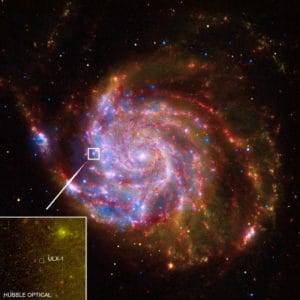
An ultraluminous X-ray source was detected in 2001 by the Chandra X-ray Observatory which was later observed in the visible-light wavelengths by the Hubble and XMM-Newton space observatories. The source of the low-energy X-ray radiation was dubbed ULX-1 and was expected to be a large black hole, as they usually are a source of this type of radiation which is also called soft X-rays. The soft, low-energy X-rays usually originate from accretion disks – the swirling disks formed from dust and gas falling into a black hole. The findings left the astronomers puzzled as they found a rather small black hole measuring between 20 and 30 solar masses, which are usually sources of high-energy radiation. The observed energy emission suggests that the black hole consumes the falling matter at the rate close to the calculated limits for this type of activity and should emit more high-energy radiation. The results of this contradictory finding remains an open question for astronomers, but there are some indications that the ULX-1 is an X-ray binary system, which means that one object in the binary is losing mass to the other object (usually a black hole or a neutron star). Accelerating matter might be a source of the X-rays. The researchers also confirmed existence of a Wolf-Rayet or WR star within the system, a type of rare stars with strange spectral emissions, surface temperatures ranging from 30 000 °C to 210,000 °C and powerful stellar winds.
The supernova dubbed SN 1909A was the first we observed. It was discovered by the German astronomer Max Wolf in 1909. In September 1951, we discovered the brightest supernova ever observed in the Pinwheel galaxy, dubbed SN 1951H, with a magnitude of 17.5. The third discovery came in January 1970, while the fourth explosion and the last one so far was detected in 2011. This type Ia supernova dubbed SN2011fe was a result of a violent collision of a binary system which usually consist of a white dwarf and another type of star. These types of supernovae are known as standard candles and are used to determine distance between the Earth and the nebulae in which they occur.
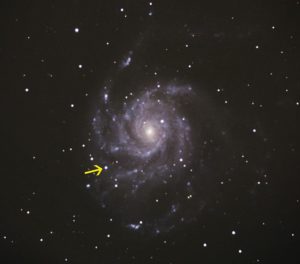
There is an abundance of H II regions – areas of ionizes hydrogen gas that surrounds newly formed stars, which make the galaxy particularly interesting for both professional and amateur observers. These bright diffuse nebulae radiate heat at about 20 000 °C and shine brilliantly in the sky. But despite this bright appearance, the galaxy is not visible to the naked eye.
Though the images show fairly symmetrical composition, the galaxy’s structure is slightly distorted by gravitational influence of its satellite galaxies. The scientists believe that its tightly wrapped spiral arms are also a result of the gravitational interactions between the galaxy and its satellites. The Pinwheel galaxy has several smaller galactic companions of different sizes and structures. The structure of these smaller companion galaxies ranges from irregular spirals to dwarf galaxies, and for some of them we are still uncertain whether they belong to the M101 group, because their distances are hard to determine and several measurements placed them within other galactic groups.
How to find it in the night sky
The location of the Pinwheel galaxy is fairly easy to determine, but at least 4-inch telescope is necessary to observe it. Though being very big and bright, the distance between our galaxy and the M101 makes it invisible to the unaided eye.
The Messier 101 is best observed in areas with no or minimal light pollution, using a fairly larger telescope or low-power eyepiece. To be able to observe its striking spiral structure, we need at least 8-inch telescope. It is best observed during the spring when the Ursa Major climbs high in the northern celestial hemisphere.
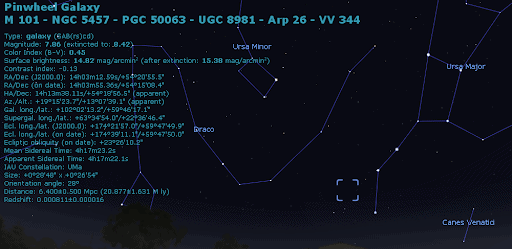
The M101 creates a triangle with the two stars in the handle of the Big Dipper. The Big Dipper asterism is sometimes used interchangeably with the Ursa Major constellation, also known as the Big Bear. The handle consists of several stars, and the Pinwheel galaxy lies slightly above the line connecting the stars known as Alkaid and Mizar.
Bibliography
[1.] “Hubble’s Largest Galaxy Portrait Offers a New High-Definition View”. NASA. 28 February 2006.
https://www.nasa.gov/mission_pages/hubble/science/hst_spiral_m10_prt.htm
[2.] NASA Content Administrator, ed. (31 May 2012). “The Pinwheel Galaxy”. NASA.
https://www.nasa.gov/multimedia/imagegallery/image_feature_2265.html
[3.] Giannakopoulou-Creighton, J.; Fich, M.; Wilson, C. D. (1999). “Star formation in the giant HII regions of M101”. The Astrophysical Journal. 522 (1): 238–249.
https://arxiv.org/pdf/astro-ph/9903334.pdf
[4.] Waller, William H.; Bohlin, Ralph C.; Cornett, Robert H.; Fanelli, Michael N.; et al. (20 May 1997). “Ultraviolet Signatures of Tidal Interaction in the Giant Spiral Galaxy M101”. The Astrophysical Journal. 481 (1): 169.
https://arxiv.org/pdf/astro-ph/9612165.pdf
[5.] Liu, Jifeng; Bregman, Joel N.; Bai, Yu; Justham, Stephen; et al. (2013). “Puzzling accretion onto a black hole in the ultraluminous X-ray source M101 ULX-1”. Nature. 503 (7477): 500–3.
https://arxiv.org/pdf/1312.0337.pdf
[6.] Hartmut Frommert & Christine Kronberg (15 Sep 2011). “Supernova 2011fe in M101”
http://www.messier.seds.org/more/m101_sn2011fe.html
Image sources
[1.] https://hubblesite.org/contents/media/images/2006/10/1865-Image.html?news=true
[2.] https://hubblesite.org/uploads/image_file/image_attachment/18524/web.jpg
[3.]https://en.wikipedia.org/wiki/Pinwheel_Galaxy#/media/File:Supernova_in_M101_2011-08-25.jpg
[4.] http://cdn.sci-news.com/images/2013/11/image_1582_1-M101-ULX-1.jpg
[5.] Stellarium app
